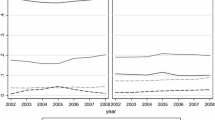Abstract
The main purpose of this paper is to assess the impact of various factors on bilateral services trade, relative to that on bilateral goods trade. To accomplish this purpose, using the standard gravity model, we ran regressions on bilateral services trade and goods trade between 10 OECD member countries and other economies (including OECD member and nonmember countries) for the years 1999 and 2000. One main and interesting result is that services trade is better predicted by gravity equations than goods trade. Another interesting result is that there is a complementary relationship between goods exports and services imports.
Similar content being viewed by others
References
Armington, P. S. (1969). A Theory of Demand for Products Distinguished by Place of Production. IMF Staff Papers 16 (1): 159–176.
Anderson, J. E. (1979). A Theoretical Foundation for the Gravity Equation. American Economic Review 69 (1): 106–116.
Anderson, J. E., and E. van Wincoop (2003). Gravity with Gravitas: A Solution to the Border Puzzle. American Economic Review 93 (1): 170–192.
Bergstrand, J. (1985). The Gravity Equation in International Trade: Some Microeconomic Foundations and Empirical Evidence. Review of Economics and Statistics 67 (3): 474–481.
Bergstrand, J. (1989). The Generalized Gravity Equation, Monopolistic Competition, and the Factor-Proportions Theory in International Trade. Review of Economics and Statistics 71 (1): 143–153.
Deardorff, V. A. (1998). Determinants of Bilateral Trade: Does Gravity Work in a Neoclassical World? In Jeffrey A. Frankel (ed.), The Regionalization of Economy. Chicago: Univerty of Chicago Press.
Di Mauro, F. (2000). The Impact of Economic Integration on FDI and Exports: A Gravity Approach. Working Document 156. Centre for European Policy Studies, Brussels.
Eaton, J., and S. Kortum (2002). Technology, Geography, and Trade. Econometrica 70 (5): 1741–1779.
Graham, E. M. (1996). On the Relationship among FDI and International Trade in the Manufacturing Sector: Empirical Results for the United States and Japan. WTO Staff Working Paper RD-96-008. Geneva.
Grünfeld, L. A., and A. Moxnes (2003). The Intangible Globalization: Explaining the Patterns of International Trade in Services. Discussion Paper 657. Norwegian Institute of International Affairs, Oslo.
Harrigan, J. (2002). Specialization and the Volume of Trade: Do the Data Obey the Laws. In K. Choi and J. Harrigan (eds.), The Handbook of International Trade. London: Basil Blackwell.
Helpman, E., and P. Krugman (1985). Market Structure and Foreign Trade: Increasing Returns, Imperfect Competition and the International Economy. Cambridge, Mass.: MIT Press.
Karsenty, G. (2000). Assessing Trade in Services by Mode of Supply. In P. Sauvé and R. M. Stern (eds.), GATS 2000: New Directions in Services Trade Liberalisation. Washington D.C.: Brookings Institution.
Kimura, F. (2003). Economic Analysis on Japan-Korea FTA: Services Trade. Mimeo. Keio University.
Lee, H.-H., and P. J. Lloyd (2002). Intra-Industry Trade in Services. In P. J. Lloyd and H.-H. Lee (eds.), Frontiers of Research in Intra-Industry Trade. London: Palgrave Macmillan.
Mirza, D., and G. Nicoletti (2004). What Is So Special about Trade in Services? Research Paper 2004/02. Leverhulme Centre for Research on Globalisation and Economic Policy, Nottingham.
OECD (2002). OECD Statistics on International Trade in Services, Detailed Tables by Partner Country 1999–2001. Paris: OECD.
OECD (2003). Total Imports and Exports for the 30 OECD Member Countries by Partner Country. Paris: OECD.
Pöyhönen, P. (1963). A Tentative Model for the Volume of Trade between Countries. Weltwirtschaftliches Archiv/Review of World Economics 90 (1): 93–100.
Tinbergen, J. (1962). Shaping the World Economy—Suggestions for an International Economic Policy. New York: The Twentieth Century Fund.
UN, European Commission, IMF, OECD, UNCTAD, and WTO (2002). The Manual on Statistics of International Trade in Services. New York: United Nations.
Author information
Authors and Affiliations
Corresponding author
Additional information
JEL no.
F10, F20, L51, F80
About this article
Cite this article
Kimura, F., Lee, HH. The Gravity Equation in International Trade in Services. Rev. World Econ. 142, 92–121 (2006). https://doi.org/10.1007/s10290-006-0058-8
Issue Date:
DOI: https://doi.org/10.1007/s10290-006-0058-8




